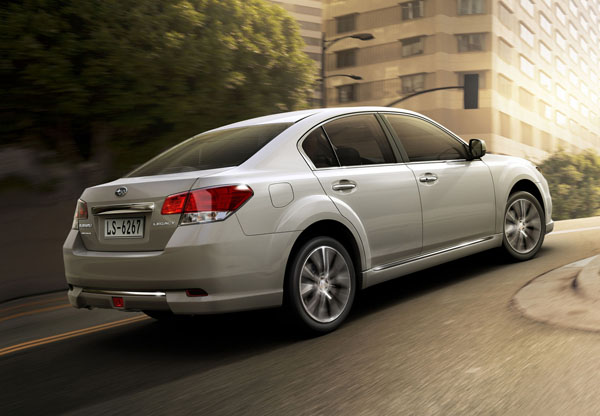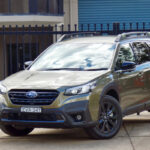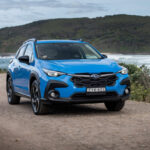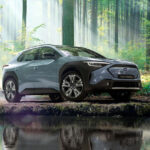
Self confidence . . . the new Subaru Liberty stands ready to defend its spot at the heart of the mid-size automobile market
The in-dash push button engine start / stop is becoming an automotive affectation. Originally it was fitted to unique racing cars and their highly tuned road-going derivatives. These days it is increasingly finding its way into vehicles of all brands and price tags.
Ironically, such a system will not work without the proximity of a computer controlled key fob, all of which requires more effort than simply slotting the key into the ignition and turning it to fire up the motor.

Sundry stressful situations tracking down the key, from pocket to centre console, were put behind me with the new Subaru Liberty 2.5 sedan – keyless entry but buttonless start-up. How good is that?
Not that there is anything yesterday about the car. For a start (or in this case stop) there’s an electric parking brake situated on a reworked centre console, a one-touch lane-change indicator, revised instrument panel, dashboard colour scheme and USB connection
The new generation horizontally-opposed boxer engine is linked to the latest Lineartronic continuously variable transmission and a revised Subaru symmetrical all-wheel-drive system. The CVT has a six-speed manual mode with steering wheel-mounted paddles.
Subaru engineers have waved a magic wand over the 2.5-litre motor to gain major improvements – power is up by three per cent (127 kW), torque by 3.3 pc (235 Nm), while fuel economy is cut by 4.8 pc (7.9 litres per 100 kilometres on the combined urban/highway cycle) and carbon dioxide emissions are down 5.7 per cent (182 g per kilometre).

Much attention was paid to the drivability of the vehicle in the mid-to-low speed torque range, while the new Lineartronic CVT is quieter, lighter and more compact.
Handling and stability have been given a fillip through revision of the all-wheel-drive system, stiffening of the suspension and a sharpened steering response. Noise vibration and harshness also comes in for improvement with changes in the construction of suspension systems.
The one-time shrinking violet looks of the Liberty have made way for a more assertive character thanks to a new grille and front fog light surrounds, plus modern alloy wheel designs.
It’s no surprise that the Liberty test car took to local conditions admirably, Australia had input here with tests being conducted Down Under.
The CVT has taken the car to a new level of fuss-free driving. The paddle-shift manual mode is competent but adds little to the overall driving experience for those wanting a little more action.
Our test car carried an option pack which includes leather upholstery, satellite navigation and new colour info display adding $3000 to the price, the sat nav sporting a particularly clear on-screen street naming, which was most welcome for this gentleman of a certain age.
Among the crop of changes to the MY13 range, the most pleasing economy for the new Liberty is a $2000 trim in price, putting the entry level model at just $32,990.
The Subaru Liberty has always maintained a spot at the heart of middle-of-the-road motoring. The latest incarnation looks to be in no mood to relinquish its position.
AT A GLANCE
MODEL RANGE
Liberty 2.5i sedan auto 32,990 Liberty 2.5i wagon auto $34,990 Liberty 2.5i sedan auto with leather and factory-fitted satellite navigation pack $35,990 Liberty 2.5i wagon auto with leather and factory-fitted satellite navigation pack $37,990 Liberty 2.5i Premium sedan auto $39,490 Liberty 2.5i Premium wagon auto $41,490
Note: These prices do not include government or dealer delivery charges. Contact your local Subaru dealer for driveaway prices.
SPECFICATIONS
ENGINE
Type: 2.5 litre naturally aspirated
Cylinders: Four, horizontally opposed
Displacement: 2498 cc
Bore x stroke: 94 mm x 90 mm / 92 mm x 91 mm
Compression ratio: 10.0:1
Maximum power: 127 kW @ 5600 rpm
Maximum torque: 235 Nm @ 4100 rpm
Fuel system: Multi-point sequential injection
Recommended fuel: 90-95 RON
DRIVELINE
Stepless Lineartronic continuously variable transmission with manual mode. All-wheel drive
DIMENSIONS, WEIGHT, CAPACITIES
Overall length: 4745 mm
Overall width: 1780 mm
Overall height: 1505 mm
Wheelbase, front: 2750 mm
Wheelbase, rear: 2750 mm
Track, front: 1530 mm
Track, rear: 1535 mm
Minimum ground clearance: 150 mm
Tare weight: 1439 kg
Turning circle: 11 m kerb to kerb
Towing capacity: 1500 kg (with brakes) / 720 kg (without brakes)
Fuel tank capacity: 65 litres
PERFORMANCE
Acceleration 0-100 km/h: 9.8 sec
Maximum speed: N / A
FUEL CONSUMPTION AND EMISSIONS
7.9 litres / 100km; 182g of CO2 per kilometre (combined cycle)
SUSPENSION AND BRAKES
Suspension: MacPherson strut type independent (front); double wishbone type independent (rear)
Brakes: Vacuum assisted ventilated discs (front); vacuum assisted discs (rear)
Steering: Engine speed sensitive power assisted rack and pinion
WHEELS AND TYRES
17-inch alloy, 17×7.5J Yokohama 215/50 R17 91V. Full-size spare
GREEN VEHICLE GUIDE
Greenhouse Rating: 6.5 / 10 Air Pollution Rating: 8.5 / 1











